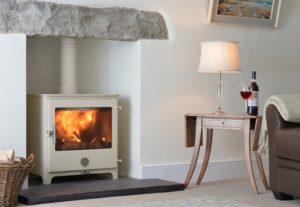
Now that Summer is here it’s easy to forget all about your stove. It has done its job for the winter and is left there until the next autumn when needed again. The stove is full of ash and the controls left in the position the stove was last run in.
In the autumn you come to use the stove again and are horrified to find it full of rust, the firebricks cracked with mould growing out of them, and that is if you can get the front door to open at all, as the handle has rusted in the shut position.
How is this damage occurring?
In the summer the outside temperature can rise suddenly and become warmer than the temperature within the house. This causes the air within the flue to reverse its normal flow pattern and air travels down the flue.
The most obvious outcome of this will initially be a smell from the flue and whilst this is not harmful it may be unpleasant if the flue has not been swept as often as it should have been.
This air will contain moisture and it is this moisture dropping into the stove which is the main cause of the damage. Metal within the stove will cool this water vapour and it will condense on the exposed surface.
In most cases cast iron or steel are the main component of a stove and rust will form. Mix this water with the ash and tars left in a stove and many and various corrosive substances are produced. The porous firebricks will absorb moisture and can become a breeding ground for bacteria and algae which can enjoy living in the bricks and they in turn produce their own waste which can damage the bricks.
A little care and maintenance will increase the longevity of the stove and save you money.
Prevention is better than cure
Here are some simple things you as the owner can do to prevent damage occurring to the stove when not in use for a long period of time.
1. Remove all ash and tars from within the stove. An ash vac is the perfect tool for this job (See Fig 1 below). Empty the ash pan and for the time you are working on the stove do not put it back in.
2. Remove the baffle or baffles from within the stove as fly ash and fallen soots can build up behind these (See Fig 2 below). Mix these with water and they can form a corrosive mixture that can in time set like concrete making it impossible to remove the baffles for future maintenance. It can also eat away the metal
of the baffle.
3. Remove all the fire bricks or cast iron protection plates from within the stove, the grate and the grate frame, if this is possible. Instructions on how to do this are generally in the instructions which are supplied with the stove. Care should be taken if the firebricks are made of the material vermiculite.
4. Again vacuum out all the ash that accumulates behind these parts.
5. Spray the inside of the stove and any metal parts removed with a water repelling spray e.g. WD40.
6. Also spray with the water repelling spray any moving parts within the stove including door latches and door handle shafts.
7. Check the condition of the door rope seals and glass seals and replace if damaged or they have become hard. It is vital for the efficient operation of
the stove that a good air tight seal is maintained.
8. If you have a stove with a painted finish, not enamelled, and this has become marked then now is the time to respray the body using paint supplied by
the stove manufacturer. Your stove will look as good as new ready for the next heating season.
9. This is also a good time to get your chimney swept by a qualified chimney sweep. It is easy to forget to do this and trying to get a chimney sweep in the autumn will not be as easy as in the early summer when there is less demand on their time. It also means your stove and flue are all ready for the next heating season. Remember when you first light the stove in the autumn to test the flue has not become blocked by nesting birds by lighting some newspaper and ensuring that all the smoke is drawn up the chimney.
